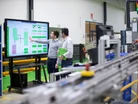Digital Transformation: How to Win the Persuasion Game

Orange is a company that has expanded far beyond telecommunications.
Its division Orange Business is a global digital transformation partner that, like industry titans Deloitte and Schneider Electric, works with manufacturers to help them effectively pursue change.
Manufacturing Digital spoke to leaders from the three companies to discuss why securing executive buy-in still remains a challenge.
Benefitting manufacturing in multiple ways
“Ever since the COVID-19 pandemic thrust a digital divide between the haves and have-nots, digital transformation has become a non-negotiable,” says Anthony Loy, Vice President of Industrial Digital Transformation at Schneider Electric.
“This is particularly true for the manufacturing sector, which continues to grow in terms of scale and complexity.”
Manufacturers today participate in complex global supply chains that span multiple geographies and industry domains. Automation, data and cloud solutions play a critical role in assembling, organising and coordinating all these moving parts. As do other more prosaic digital technologies.
Schneider Electric’s latest research in partnership with OMDIA shows that 60% of industrial companies predict that digital transformation will have a major impact on their operations in the next two to three years.
This is already borne out on the ground.
“Every day I talk and work together with customers to see how they can use common technology,” says Sam Waes, Head of Smart Industries at Orange Business.
“Remote access, for example. It sounds like a very obvious thing, but if you talk from an OT and IT point of view, it can bring incredible transition and change to a factory.
“People can work more flexibly, everything can be coordinated and organised better. It’s a lot easier to optimise your factory without needing people to constantly visit the factory floor. So this is also innovation.”
This innovation has been enabled by the rise of software-led manufacturing, according to Brian Zakrajsek, Smart Manufacturing Leader at Deloitte.
“What that software-led manufacturing boils down to is that manufacturers don't have to be coupled to the physical world; it doesn’t determine how they innovate,” he says.
“You can have a legacy piece of equipment that you're continually iterating, sustaining, innovating, adding new capability on and integrating into broad sets of use cases in real time.”
IoT solutions, like orchestrating industrial data, were once just concepts. Today, they are viable solutions that provide tangible improvements to productivity and efficiency. The shift towards software has shifted mindsets too, as manufacturers seek guidance on how to best use the technologies at their disposal.
“Just because digital transformation is important doesn’t mean that it’s easy to achieve.” warns Anthony. “Various barriers continue to block the path towards greater productivity, energy and resource efficiency and quality.”
One of the biggest barriers is convincing executives of digital transformation’s business benefits.
Defining the business benefit of digital transformation
“The cost of implementation is considered the most significant challenge, particularly in terms of integrating digital transformation capabilities with an organisation’s existing control system,” Says Anthony.
“There are also concerns about understanding what technologies to invest in and the challenges in identifying the right partners, across programme design, execution and system deployment.”
Another major challenge is communicating digital transformation’s business value. From a business perspective there is a lot at stake when making changes, considering the costs of manufacturing downtime, which engenders a lot of scepticism about digital transformation projects.
This scepticism is fuelled by the tendency to embrace digital solutions in siloes instead of a holistic shift in operations. With this in mind, the language manufacturers use to propose digital solutions is of paramount importance.
A great example of this is AI.
Becoming articulate about AI
The enthusiasm for AI in the manufacturing industry cannot be understated. According to Forbes, the AI market is projected to reach $US407bn by 2027.
According to Latest Industry Reports, The global Artificial Intelligence (AI) in Manufacturing market was valued at US$2.54bn in 2023 and is anticipated to reach US$3.2bn by 2030, a compound annual growth rate of 3.3% during the forecast period 2024-2030.
Sam emphasises though that AI, regardless of its nature as generative or predictive, needs to be discussed in terms of its business case. This is something which he feels manufacturers, despite their enthusiasm, are struggling to do.
“A lot of manufacturers are enthusiastic about AI, but they struggle to articulate that kind of business perspective, how this is actually going to benefit us,” Sam says, pointing to Orange Business’s collaboration with Surveily to enhance safety through AI-powered CCTV.
“Our work with Surveily is a very nice example. You can see that it's about safety. If we’re presenting a solution and talking about AI, it means we haven't found the right business case.”
Sam, and by extension Orange Business, recognises that all forms of digital transformation must serve business needs and goals. Technology is a strategic investment that can enhance operations and enable companies to better serve employees and, critically, customers.
Sam is another believer in AI’s potential to fundamentally reshape the world and the manufacturing industry.
“I believe it will be a bigger change than the change of implementing the internet,” he says, reflecting on his time as an internet coordinator for a factory before the rise of the internet we know today.
“The change from not having to having the internet…nobody could see what was happening, the future that lay ahead of us.”
The internet, Sam points out, has been transformative: full of life-changing forms of community, entertainment and information. It’s also full of unfathomable horrors. Anyone who’s spent ten minutes in a chatroom or an Instagram comments section knows that.
Does this mean we should turn away from it completely? Of course not.
AI, like the internet, is in its essence a neutral tool. What defines its value and impact is the purpose and intent behind its use.
Core to communicating AI’s business value is underlining its strategic value and purpose, as an organisational tool to enhance knowledge, efficiency and productivity. This is especially important considering AI is inherently less predictable than other industry 4.0 technologies, according to Brian.
“Philosophically, Deloitte's actually done a tremendous amount of work around the concept of trust.” he says.
“One of the paradigm shifts that happens when you use AI is that AI is probabilistic, like classic automation is deterministic. We programme a robot to do something and it's going to do it with almost 100% certainty. With AI, we don't have that, so we need to enhance the confidence models surrounding it.”
A need to enhance the confidence surrounding AI mirrors attitudes on the executive level towards digital transformation as a whole, which is why articulating coherent ROI is a must.
The need to communicate ROI
“Defining how you will measure the performance of the digital transformation project is crucial to bolstering buy-in,” says Anthony.
“Your organisation will need the capacity to track the value generated to unlock a full picture of its progress. So, keep it simple and be clear with what success would look like.”
Communicating this return on investment and laying out a strategic roadmap are absolutely critical. Sam says he often sees clients with factory initiatives that are not expansive enough, keeping conversations with smaller vendors on a local factory level. Digital transformation implementation projects need to be executed across operations, which is where he believes Orange as a global organisation can help.
“A lot of transition needs to be done,” Sam concludes. “ And we have that broad view on what is happening, a truly global view that helps us address companies' needs on that scale.”
Anthony notes that considering impact at every stage of the digital transformation process is also crucial to executing and presenting projects successfully.
“Financial metrics are always critical, but so too are qualificative metrics,” he says.
“Remember to consider the impact of the projects on your sustainability, resilience and cybersecurity capabilities, including more visibility, IT costs and shadow IT and managing legacy systems.
“You should also consider the impact on employees, from upskilling to attractiveness to new staff. After all, the OMDIA research shows that almost all employees will be required to retrain to some extent following the installation of new workplace technology.”
Ultimately, digital transformation projects require end-to-end understanding of how to deliver on ROI while responding to impact on operations and employees. Deep domain experience and a holistic approach are critical to both securing buy-in and managing projects once launched. But planning can only take you so far.
“Digital transformation will always involve a leap of faith to some extent,” concludes Anthony.
“Delivering the return on investment on the first use cases selected will require leadership and organisational commitment to transform the current way of working.”
To read the full story in the magazine click HERE
******
Make sure you check out the latest edition of Manufacturing Digital and also sign up to our global conference series - Procurement & Supply Chain 2024 & Sustainability LIVE 2024
******
Manufacturing Digital is a BizClik brand.


